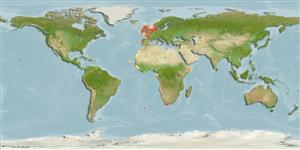Common names from other countries
Environment: milieu / climate zone / depth range / distribution range
экология
; пределы глубины 0 - 80 m (Ref. 104052). Temperate
Eastern Atlantic and the Mediterranean: from the North Sea to Morocco and Bay of Biscay, extending southwards to Namibia including off lying islands.
Length at first maturity / Size / Вес / Возраст
Maturity: Lm 13.0 range ? - ? cm Max length : 22.0 cm CL самец/пол неопределен; (Ref. 104052)
Maximum depth from Ref. 115714. Juveniles about to reach maturity live in shallow waters from 10 to 15 m deep on rocky and sandy substrates (Ref. 115713). They are also found on sandy bottoms colonized by Zostera marina. During summer, adults live near the shore on rocky areas. In winter, they are spotted on rocky bottoms and heterogeneous coarse sediments in deep waters. Both juveniles and adults during summer are found on muddy sands with few rocks (Ref. 115714). Uses slow, small-scale, non-directional movements. Exhibiting ontogenetic movements, juveniles live at depth of 5 to 15 m; adults then migrate to deeper waters (>50 m), where they mate (Ref. 115713). Diet remains to be accurately described. Studies (i.e. direct field observations, laboratory experiments, and gut content analyses) have suggested the species to have an omnivorous diet based on consumption of prey commonly found in their habitat (Ref. 115714). In one study, however, it was considered a mobile carnivorous species (Ref. 96498). Research using stable isotopes indicate no differences between sexes in diet or habitat use patterns either in adults (Refs. 115714, 115744) or juveniles (Refs. 115713, 115714, 115744).
Members of the order Decapoda are mostly gonochoric. Mating behavior: Precopulatory courtship ritual is common (through olfactory and tactile cues); usually indirect sperm transfer.
Основная ссылка
ссылки | координатор | соавторы
Le Pape, O., L. Baulier, A. Cloarec, J. Martin, F. Le Loc'h and Y. Désaunay. 2007. (Ref. 96498)
Статус Красного Списка МСОП (Ref. 130435)
Статус СИТЕС (Ref. 108899)
Not Evaluated
Not Evaluated
Угроза для людей
Harmless
Использование человеком
рыболовство: коммерческий
| FishSource |
инструменты
дополнительная информация
Возраст/РазмерыростЗависимость между длиной и массой телаЗависимость между длинамиморфологияличинкичисленность
ресурсы в Интернет
Estimates based on models
устойчивость к внешним воздействиям
высокий, минимальное время удвоения популяции до 15 месяцев (Fec=300,000).
